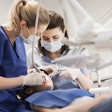
Editor's note: This is a continuation of a yearlong series that is designed to help dentists and team members understand their practice management software better. Today, we are providing you with another Eaglesoft tip from Ann-Marie DePalma, a technology adviser with Patterson Dental. Earlier this month, we posted a Q&A from experts representing Dentrix and Curve Dental. Additionally, we are also working on the same article format for other practice management software systems.
Q: What are unassigned credits and how do they occur?
A: In Eaglesoft, any payments or adjustments, whether by the patient or insurance, must be attached to a service. When this does not happen, an unassigned credit is created. Attaching a service to a payment/adjustment is considered line item accounting. Line item accounting enables the user to apply a payment/adjustment to a specific line item. It is an excellent way to group services and payment/adjustments that are related together so that the account ledger is easier to manage. Additionally, when there are associates in a practice and they are paid on collections, line item accounting ensures that the associate is receiving the correct credit for any payments on services he or she performed. If line item accounting is not used correctly, an associate may be getting overpaid or underpaid.
 Ann-Marie DePalma, CDA, RDH, MEd.
Ann-Marie DePalma, CDA, RDH, MEd.Unassigned credits begin right from the walkout. Many team members inadvertently create unassigned credits by the way a payment or an adjustment is entered at the time of walkout. If the payment is not entered correctly at the time of walkout, when insurance payments and adjustments are entered, the insurance reimbursement amounts cannot be properly assigned to the appropriate line item. This can cause confusion for the patient and team members when reviewing the account. When all information is appropriately entered, a simple right-click on the line item to view the distribution can explain how payments and adjustments were received for the service.
One example of an unassigned credit is a patient prepayment. With a patient prepayment, there is not a service to which you can attach the payment, so an unassigned credit is created and must be attached correctly when the service is walked out. Another example is when a payment is not attached to the correct service or to the correct family member. For instance, an unassigned credit will appear when the account has a zero balance but there are credits on the account, or the unpaid balance is on one family member, but another has a credit balance.
Unassigned credits within accounts that have a total credit balance make the practice's accounts receivable appear lower than actual. To determine the true accounts receivable (A/R), the Accounts Receivable by Responsible Party Report can be used, filtered by range of account balances with either positive or negative numbers, depending on if the true A/R is desired or to determine the total amount of accounts with credit balances. There are also several other reports such as the Offsetting Debits and Credits and Unassigned Credit reports which can be utilized.
Dealing with unassigned credits can be confusing, but understanding their effect is important in determining the true practice A/R. Several settings in the File/Preference and in the Provider/Staff areas also need to be correct for accurate reporting given the practice's needs. You can get more information by reviewing FAQ 11911 (line item accounting), FAQ 21051 (unassigned credits – payments with $? symbol), FAQ 18703 (unassigned credits applied to today's services at the walkout), and FAQ 12997 (patient debit balance and credit on the same account), or contact your local Patterson software technology adviser to learn more about unassigned credits.
Ann-Marie DePalma, CDA, RDH, MEd, is a fellow and certified educator of the Association of Dental Implant Auxiliaries (ADIA) and a fellow of the American Academy of Dental Hygiene (AADH). She spent more than 25 years in clinical hygiene and is currently employed as a technology adviser/trainer for Patterson Dental. She can be reached by email.
The comments and observations expressed herein do not necessarily reflect the opinions of DrBicuspid.com, nor should they be construed as an endorsement or admonishment of any particular idea, vendor, or organization.



















